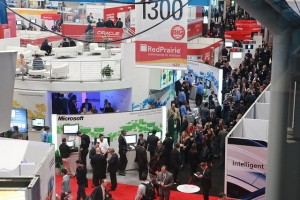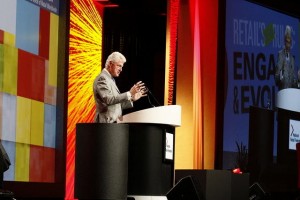
National retail and food services sales for December came in below expectations, but still topped a seasonally adjusted $400 billion for just the second month on record, leading industry experts to debate whether the holiday-season momentum will continue.
The mood was upbeat at the National Retail Federation”™s 101st annual Convention and Expo, held Jan. 15-18 at the Javits Center in New York City, where 400 exhibitors and more than 22,000 attendees heard from former President Bill Clinton and a number of leading executives about the industry”™s growth potential coming off a strong holiday season.
In Fairfield and Westchester counties, there was a consensus among storeowners and consumers that while foot traffic and holiday spending were likely up compared with the previous year, industry reports of greater than 4 percent growth may have been overstated.

“The bottom line is very mixed,” said Howard Davidowitz, chairman of Davidowitz and Associates Inc., a national retail consulting and investment banking firm based in New York City.
While there were definite winners ”“ among them Macy”™s Inc., Abercrombie and Fitch Co. and The Limited ”“ Davidowitz said department store sales underperformed during the holidays and that huge sales likely cut into the bottom line for many retailers.
“The department store business ”“ if you look at it, the largest department store in the U.S., Sears, is in total collapse; (JCPenney) is poor, and Kohl”™s is bad. That”™s not good,” he said, also noting that Target Corp. and Best Buy Co. Inc. both missed their seasonal revenue goals.
Koshy Chacko, president of the Westchester-Rockland chapter of the New York State Restaurant Association, said local establishments have seen a steady ”“ albeit gradual ”“ increase in business compared with a year ago.
“In talking to other restaurant owners, we had a better year than last year,” said Chacko, owner of Fair Deal Café in White Plains. “I don”™t expect any rapid growth but … there are still restaurants opening up, so that is a positive sign.”
The U.S. Commerce Department reported earlier this month that December retail and food services sales rose just 0.1 percent compared with November 2011 and by 6.5 percent compared with December 2010. Excluding sales of motor vehicles and motor vehicle parts, retail and food services sales posted a 6 percent increase from the previous December.
The small monthly gains came after a 0.4 percent increase in sales from October to November. The median estimate of economists surveyed by Bloomberg News had projected a 0.3 percent increase from November to December.
SUBHED: Showing strength
Despite the lower-than-expected December sales, Commerce Secretary John Bryson noted that the retail sector bounced back in record fashion in 2011 with $4.7 trillion in total retail and food services sales.
“Retail sales showed important strength last year, increasing 7.7 percent from 2010 to 2011,” Bryson said in a statement.
The NRF also reported that holiday sales ”“ defined by the organization as retail industry sales during November and December ”“ grew by 4.1 percent to $471.5 billion, topping expectations of 3.8 percent annual growth.
With the economy showing definitive signs of recovery, Terry Lundgren, CEO and chairman of Macy”™s Inc. and chairman of the NRF, told those in attendance at last week”™s convention that retail ”“ which employs one out of every four workers ”“ is uniquely positioned to lobby Congress for meaningful legislative action to boost job growth.
“We are seeking to educate our policymakers on the value of the retail industry and make it crystal clear that if retail is not creating jobs, it”™s very unlikely…that jobs are going to be created (and) that unemployment numbers are going to actually improve,” he said. “So, Washington D.C. ought to be doing everything possible to create tax and legislative policy which will enable and encourage growth for all retailers.”
Clinton wants reform
Clinton gave the keynote presentation at the convention, calling on Congress and the private sector to take action to stem lingering high unemployment levels.
He repeated a phrase that has become somewhat of a calling card, saying, “We”™ve got to get America back in the future business.”
Doing that means capitalizing on high-end manufacturing and energy-efficient building technologies; reforming the health care system, corporate tax structure, and education system; helping Americans get mortgage debt under control; and addressing the country”™s soaring debt while also stimulating new economic growth, he said over the course of his address.
What is needed, Clinton said, is a systematic reform.
“System building is a big problem. In rich countries we”™ve got systems ”“ that”™s how we got rich. But they inevitably get long in the tooth. They find themselves being eroded by people who are … more interested in claiming more of the nation”™s wealth in the present than throwing enough of it into the future. We have good systems but we need to reform them.”



















